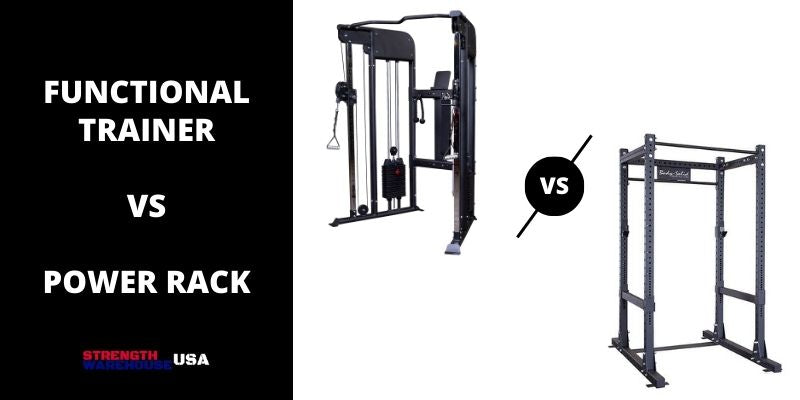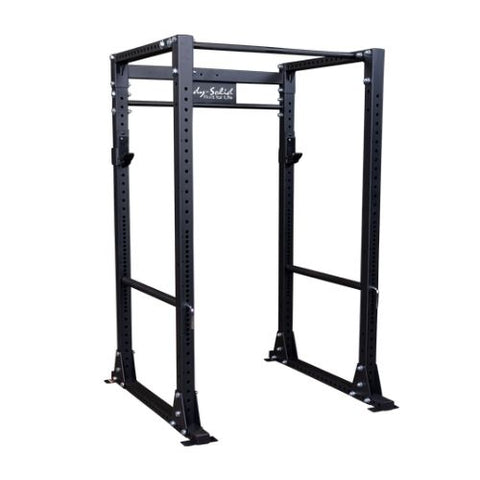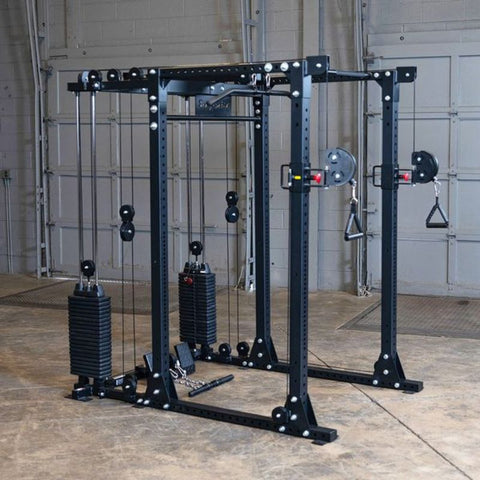Building your dream gym? Don’t sweat the small stuff, but definitely sweat the big ticket tools that will help get you fit. The right gym equipment can help make or break your weight training goals, even if you are just starting.
A common head-scratcher space and budget conscious home gym owners is the decision between the functional trainer and the power rack. Both of these options excel in their different areas and unique contribute to your training regimen.
The functional trainer is a versatile piece of equipment that offers a range of cable exercises, allowing for targeted full-body workouts with freedom of movement.
In comparison, the power rack is your go-to for heavy lifting and compound exercises and is the cornerstone for your free weight exercises. It provides secure uprights, barbell holders and safeties to be used as a sturdy base for squats, presses, and other barbell-centric movements.
This article will compare the functional trainer and power rack to help you make an informed decision prior to buying any home gym machines.
Functional Trainer vs Power Rack: Comparing Functionality
In the debate between functional trainers and power racks, understanding the unique functionalities of each is crucial for choosing the right equipment for your fitness journey. While functional trainers excel in facilitating dynamic, multi-planar movements, power racks offer unparalleled support and safety for heavy compound lifts, catering to different training preferences and goals.
Both functional trainers and power racks are fantastic gym equipment for your home gym setup for strength training and a full-body workout. Let's break down what each is, how they work and the different features of each:
The Functional Trainer: Your Go-To for Cable Training
A functional trainer is a type of exercise equipment typically found in gyms, designed to facilitate a wide range of functional movements and exercises targeting multiple muscle groups. It usually consists of adjustable pulleys, cables, and various attachments to accommodate diverse workout routines for strength, stability, and flexibility.
Conventional gym equipment can feel a bit restrictive, but a functional trainer significantly changes this. It is considered by many to be the most versatile piece you can buy for a gym. This machine will allows you to do everything from shoulder mobility work to bicep curls to pull ups and whatever else falls in between.
How a Functional Trainer Works:
A functional trainer utilizes adjustable pulleys and cables to provide resistance throughout a wide range of motion, allowing users to perform various exercises targeting specific muscle groups or functional movements. By adjusting the height, angle, and resistance level, users can customize their workouts to suit their fitness goals and abilities.
We also recommend checking out our popular functional trainer exercises, which will hopefully get your creative juices flowing on how to use a functional trainer for your routine.
One of our buyers, John, who’s in his late 60s, found the Body-Solid PFT100 Functional Trainer really handy for these workouts. He liked how easy it is to change the weights quickly and use them for different exercises.
Functional Trainer Features:
The functional trainer is a popular variation of cable machines that offers a multitude of features for comprehensive workouts. From adjustable pulleys and a cable system to stability features and optional accessories, it provides everything needed to tailor exercises to individual preferences and fitness goals. Here's a list of all the most common features on a functional trainer:
-
Adjustable pulleys: Allow for customization of exercise angles and heights.
-
Cable system: Provides resistance for exercises targeting different muscle groups.
-
Universal attachments: Such as handles, bars, and straps for versatile workout options.
-
Weight stack or weight plates: Provide resistance levels for varying intensity using guide rods and stacked weight plates
-
Pull-up bar: Allows for upper body exercises like pull-ups and chin-ups.
-
Compact design: Saves space in home or gym settings compared to a cable crossover or multi-stack gym system.
-
Optional accessories: Such as benches or platforms for expanded exercise possibilities.
The Power Rack: Your Go-To for Heavy Lifting
A power rack, also called a squat rack, is built with solid uprights, adjustable J-cups, safety bars, and a pull-up bar that serve as a structural component for the top of the frame. It holds barbells at different heights, making them perfect for exercises like squats, bench presses, and overhead presses.
It's no wonder commercial gyms often have dedicated areas for power racks; they're a favorite among strength training enthusiasts who want to build muscle safely and effectively.
The power rack shines when it comes to heavy compound lifts. Squats, bench presses, overhead presses—all these exercises find their place in the power rack's sturdy frame.
Adjustable safety pins catch the barbell if you can't complete a rep, and some racks even have spotting arms for extra support. This allows you to push your limits with heavy weights with peace of mind. Power racks are ideal for routines focused on building raw muscle strength.
How a Power Rack Works:
A power rack, also known as a squat rack or power cage, is a sturdy piece of gym equipment designed to support various strength-training exercises, primarily focusing on compound movements like squats, bench presses, and overhead presses. It typically consists of four vertical posts with adjustable safety bars and horizontal supports, providing a secure environment for lifting heavy weights safely alone or with a spotter.
We have compiled a list of the best squat rack exercises to help you hit your fitness goals.
Power Rack Features:
The power rack stands as a cornerstone of any serious strength training regimen, offering a robust framework equipped with a range of essential features. From adjustable safety bars and pull-up bars to convenient weight plate storage and optional accessories, it provides a comprehensive platform for safe and effective workouts tailored to individual needs and goals.
-
Sturdy steel construction: Provides stability and durability for heavy lifting.
-
Adjustable safety bars: Allow for customized height settings to catch weights during lifts.
-
Pull-up bar: Enables upper body exercises like pull-ups and chin-ups.
-
J-hooks or bar catches: Hold the barbell securely in place for squats, bench presses, and other exercises.
-
Safety pins or spotter arms: Offer additional safety during solo lifting sessions.
-
Weight plate storage: Conveniently holds weight plates for easy access during workouts.
-
Optional accessories: Such as dip bars, landmine attachments, and cable pulley systems for expanded exercise variety.
-
Compact footprint: Fits well in home gyms or commercial facilities with limited space.
There are different kinds of power racks available, such a 4-post rack or a 2-post rack commonly referred to as a half rack. They still function in the same manner however, so opt for what you're comfortable with in your space and budget.
Considerations for Home Gym Owners
Setting up your home gym is exciting, but it's crucial to consider a few key factors to ensure it aligns perfectly with your personal goals.
A few things to consider when deciding between a functional trainer vs squat rack:
Space Considerations
Assess your training space. Functional trainers are compact and flexible, ideal for small spaces, while power racks often require more room, especially for exercises like squats and overhead presses.
Overall Fitness Goals
If you prioritize a variety of exercises mimicking everyday movements, a functional trainer would be the ideal choice for you. But if your focus is tilted towards heavy lifting and building muscle strength, a power rack is a secure platform for compound exercises like squats and bench presses.
Budget & Long Term Value
Functional trainers might have a higher initial price tag, but they offer a wide range of exercises. This makes them cost-effective in the long run, as you essentially get multiple machines in one. Power racks are cheaper upfront if you are on a tight budget, but factor in the cost of additional equipment like a barbell and weight plates which are a requirement to even consider owning a squat rack.
With these considerations in mind, you can create a home gym that not only fits your space and budget but also helps you achieve your fitness goals effectively.
The Best of Both Worlds: A Power Racks with Built-in Functional Trainer
What if you are on the lookout for something that combines the best of both worlds? Enter the power rack with a functional trainer built-in, a complete all-in-one trainer that can take your space to the next level.
This set up seamlessly integrates the strong frame and safety features of a traditional power rack with cable pulleys and weight stacks you’d find in a functional trainer. This combination translates to a game changer for compact home gyms and private facilities:
-
Versatility and Adaptability: Combining the features of both a power rack and a functional trainer provides a wide range of exercise options, catering to various fitness goals and preferences. Users can customize their workouts by utilizing either the power rack or the functional trainer independently or incorporating both for comprehensive training sessions tailored to individual needs and preferences.
-
Space-saving Design: Instead of purchasing separate equipment, having a power rack with a built-in functional trainer saves space in home gyms or commercial facilities.
-
Comprehensive strength training: Users can perform heavy compound lifts safely within the power rack while utilizing the functional trainer for dynamic, multi-planar movements, ensuring a well-rounded strength training routine.
-
Time Efficient Workouts: With both functionalities integrated into one unit, transitioning between exercises is seamless, optimizing workout efficiency and time management. Having both a power rack and functional trainer in one unit eliminates the need to switch between different pieces of equipment, streamlining workout routines and enhancing convenience.
Something like the Body-Solid GPR400 Power rack with GPRFT Functional Trainer add-on might be the perfect solution for you!
Power Rack vs Functional Trainer Conclusion
For fitness enthusiasts seeking versatile, space-saving workouts with a focus on rehabilitation, functional trainers stand out. Power racks prioritize stability and safety, catering to heavy lifters performing squats and presses, although additional equipment may be required.
Hybrid options seamlessly combine both functionalities, but it's crucial to consider factors like the weight and adjustability of the cable system.
Finally, prioritize your fitness goals: whether it's achieving variety or focusing on heavy lifting—and assess the available space in your home gym.
If you are unsure of what you might need, just reach out and contact us for help! We're happy to assist in any way we can.
Continued Reading
Want to learn more about squat racks and functional trainers? Check out these resources:
Functional Trainer Versus Series





Leave a comment